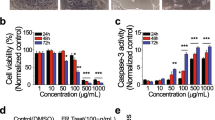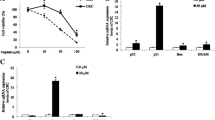Abstract
The present study was initiated to examine the anticancer effects of Anhuienoside C (AC) against ovarian cancer and postulates the possible molecular mechanism of its action. 3-[4,5-Dimethylthiazol-2-yl]-2,5 diphenyl tetrazolium bromide assay was implemented for determination of the effects of AC on cell viability of the ovarian cancer OVACAR-3 cell line. To study cellular morphology, phase contrast microscopy was performed. Apoptosis was examined via acridine orange/ethidium bromide used staining assays. Flow cytometry was used to check the different phases of the cell cycle. Cell migration and invasion assays were performed via transwell chamber assay. The effects of AC on expression of phosphoinositide 3-kinases (PI3K), protein kinase B (AKT), and mammalian target of rapamycin (mTOR) protein in ovarian cell were assessed using western blotting assay. The results indicated that the cell proliferation rate lowered in AC-treated OVACAR-3 cells as compared to the untreated controls in a dose-dependent manner. Cell morphology changed substantially by the exposure to AC and remained dose dependent. These morphological changes were indicative of apoptotic cell death. Apoptosis analysis showed dose-dependent increase of apoptosis. The cell migration and invasion of OVACAR-3 cells was reduced to a minimum by AC in a dose-dependent manner. Finally, western blotting assay showed blocking of PI3K/AKT/mTOR signaling pathway with increasing AC doses. Taking all together, AC is a potential ovarian cancer inhibitor. It induces its anti-ovarian cancer effects via induction of apoptosis, delaying cell migration and invasion, and blocking PI3K/AKT/mTOR signaling pathway.





Similar content being viewed by others
Data availability
Enquiries about data availability should be directed to the authors.
Change history
19 August 2023
This article has been retracted. Please see the Retraction Notice for more detail: https://doi.org/10.1007/s11010-023-04829-6
References
Torre LA, Bray F, Siegel RL et al (2015) Global cancer statistics, 2012. CA Cancer J Clin 65:87–108
Knutson KL, Karyampudi L, Lamichhane P, Preston C (2015) Targeted immune therapy of ovarian cancer. Cancer Metastasis Rev 34:53–74
Au KK, Josahkian JA, Francis JA, Squire JA, Koti M (2015) Current state of biomarkers in ovarian cancer prognosis. Fut Oncol 11:3187–3195
Vaughan S, Coward JI, Bast RC et al (2011) Rethinking ovarian cancer: recommendations for improving outcomes. Nat Rev Cancer 11:719–725
He QZ, Luo XZ, Wang K et al (2014) Isolation and characterization of cancer stem cells from high-grade serous ovarian carcinomas. Cell Physiol Biochem 33:173–184
Newman DJ, Cragg GM (2012) Natural products as sources of new drugs over the 30 years from 1981 to 2010. J Nat Prod 75:311–335
Graham JG, Quinn ML, Fabricant DS, Farnsworth NR (2000) Plants used against cancer—an extension of the work of Jonathan Hartwell. J Ethnopharmacol 73:347–377
Zhang LT, Zhang YW, Takaishi Y, Duan HQ (2008) Antitumor triterpene saponins from anemone flaccida. Chin Chem Lett 19:190–192. https://doi.org/10.1016/j.cclet.2007.11.029
Liu Q, Xiao XH, Hu LB et al (2017) Anhuienoside C ameliorates collagen-induced arthritis through inhibition of MAPK and NF-κB signaling pathways. Front Pharmacol 8:299
Wang C, Jiang Y, Yu K, Liu K, Wang H (2020) Anhuienoside C attenuates podocyte injury in diabetic nephropathy rats. Dose Response 18(3):1559325820939010. https://doi.org/10.1177/1559325820939010
Zhang B, Xu X, Ma Q, Qin H, Zhang J, Pang H et al (2020) Anhuienoside C ameliorates atherosclerosis in rats via regulation of the NFκB/eNOS/NO signaling pathway. Trop J Pharm Res 19(4):721–726. https://doi.org/10.4314/tjpr.v19i4.7
Sun B, Su T, Zhibin (2022) Anhuienoside C ameliorates osteoclast differentiation in ovariectomy-induced osteoporosis by regulating RANKL/Wnt signaling pathways. Curr Top Nutraceutical Res 20(1):51–55
Yang X, Guo F, Peng Q, Liu Y, Yang B (2019) Suppression of in vitro and in vivo human ovarian cancer growth by isoacteoside is mediated via sub-G1 cell cycle arrest, ROS generation, and modulation of AKT/PI3K/m-TOR signalling pathway. J BUON. 24(1):285–290
Jaudan A, Sharma S, Malek SNA, Dixit A (2018) Induction of apoptosis by pinostrobin in human cervical cancer cells: possible mechanism of action. PLoS ONE 13(2):e0191523. https://doi.org/10.1371/journal.pone.0191523
Matulonis UA, Sood AK, Fallowfield L, Howitt BE, Sehouli J, Karlan BY (2016) Ovarian cancer. Nat Rev Dis Prim 25(2):16061. https://doi.org/10.1038/nrdp.2016.61
Varghese E, Samuel SM, Sadiq Z, Kubatka P, Liskova A, Benacka J, Pazinka P, Kruzliak P, Büsselberg D (2019) Anti-cancer agents in proliferation and cell death: the calcium connection. Int J Mol Sci 20(12):3017. https://doi.org/10.3390/ijms20123017
Pistritto G, Trisciuoglio D, Ceci C, Garufi A, D’Orazi G (2016) Apoptosis as anticancer mechanism: function and dysfunction of its modulators and targeted therapeutic strategies. Aging (Albany NY) 8(4):603–619. https://doi.org/10.18632/aging.100934
Acknowledgements
All the authors of presented report thankful to The First Affiliated Hospital of Soochow University, China for providing necessary facility to conduct the work.
Funding
The authors have not disclosed any funding.
Author information
Authors and Affiliations
Corresponding author
Ethics declarations
Conflict of interest
The authors declare that there is no conflict of interest to indicate.
Ethical approval
All the experimental protocols were approved by Institutional Animal Care and Use Committee of Yancheng No.1 People Hospital, China (IACUC/YPH/12/2020).
Additional information
Publisher's Note
Springer Nature remains neutral with regard to jurisdictional claims in published maps and institutional affiliations.
This article has been retracted. Please see the retraction notice for more detail: https://doi.org/10.1007/s11010-023-04829-6
Rights and permissions
Springer Nature or its licensor (e.g. a society or other partner) holds exclusive rights to this article under a publishing agreement with the author(s) or other rightsholder(s); author self-archiving of the accepted manuscript version of this article is solely governed by the terms of such publishing agreement and applicable law.
About this article
Cite this article
Zhu, Y., Yang, L. & Chen, Y. RETRACTED ARTICLE: Anhuienoside C inhibits human ovarian cancer cell growth by inducing apoptosis, suppression of cell migration and invasion, and targeting PI3K/AKT/mTOR signaling pathway. Mol Cell Biochem 477, 1887–1892 (2022). https://doi.org/10.1007/s11010-022-04406-3
Received:
Accepted:
Published:
Issue Date:
DOI: https://doi.org/10.1007/s11010-022-04406-3




